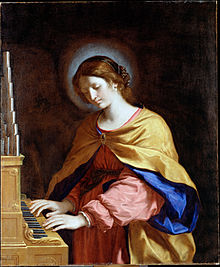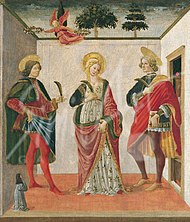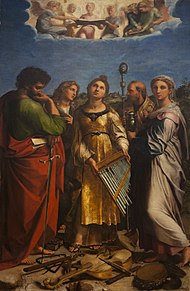Cecilia | |
|---|---|
 Saint Cecilia playing the pipe organ | |
| Virgin and martyr | |
| Born | 200–230 AD Rome |
| Died | 222–235 AD[1] Rome |
| Venerated in | Orthodox Church Roman Catholic Church Anglican Communion Lutheran churches |
| Major shrine | Santa Cecilia in Trastevere, Rome |
| Feast | 22 November |
| Attributes | Flute, organ, roses, violin, harp, harpsichord, songbird, singing |
| Patronage | Sacred music, organ builders, luthiers, singers, musicians, poets, Archdiocese of Omaha, Albi, France, Mar del Plata, Argentina |
Saint Cecilia (Latin: Sancta Caecilia), also spelled Cecelia, was a Roman virgin martyr and is venerated in Catholic, Orthodox, Anglican, and some Lutheran churches, such as the Church of Sweden.[2] She became the patroness of music and musicians, it being written that, as the musicians played at her wedding, Cecilia "sang in her heart to the Lord".[3][4] Musical compositions are dedicated to her, and her feast, on 22 November,[5] is the occasion of concerts and musical festivals. She is also known as Cecilia of Rome.
Saint Cecilia is one of several virgin martyrs commemorated by name in the Canon of the Mass in the Latin Church. The church of Santa Cecilia in Trastevere, founded in the 3rd century by Pope Urban I, is believed to be on the site of the house where she lived and died.

It is popularly supposed that Cecilia was a noble lady of Rome[4] who, with her husband Valerian, his brother Tiburtius, and a Roman soldier named Maximus, suffered martyrdom in about 230, under the Emperor Alexander Severus.[6][7] Giovanni Battista de Rossi, however, argues that instead she perished in Sicily under the Emperor Marcus Aurelius between 176 and 180, citing the report of Venantius Fortunatus, Bishop of Poitiers (d. 600).[8]
According to the story, despite her vow of virginity, her parents forced her to marry a pagan nobleman named Valerian. During the wedding, Cecilia sat apart singing to God in her heart, and for that, she was later declared the saint of musicians.[4] When the time came for her marriage to be consummated, Cecilia told Valerian that watching over her was an angel of the Lord, who would punish him if he sexually violated her but would love him if he respected her virginity. When Valerian asked to see the angel, Cecilia replied that he could see the angel if he would go to the third milestone on the Via Appia and be baptized by Pope Urban I. After following Cecilia's advice, he saw the angel standing beside her, crowning her with a chaplet of roses and lilies.[4]

The martyrdom of Cecilia is said to have followed that of her husband Valerian and his brother at the hands of the prefect Turcius Almachius.[9] The legend about Cecilia's death says that after being struck three times on the neck with a sword, she lived for three days, and asked the pope to convert her home into a church.[10]
St. Cecilia was buried in the Catacomb of Callixtus and later transferred to the Church of Santa Cecilia in Trastevere. In 1599, her body was found still incorrupt, seeming to be asleep.[4]
Cecilia is one of the most famous Roman martyrs, although some elements of the stories recounted about her do not appear in the source material.[10] According to Johann Peter Kirsch, the existence of the martyr is a historical fact. At the same time, some details bear the mark of a pious romance, like many other similar accounts compiled in the fifth and sixth centuries. The relation between Cecilia and Valerian, Tiburtius, and Maximus, mentioned in the Acts of the Martyrs, has some historical foundation. Her feast day has been celebrated since about the fourth century.[11] There is no mention of Cecilia in the Depositio Martyrum, but there is a record of an early Roman church founded by a lady of this name, Santa Cecilia in Trastevere.[12]
|
Main article: Santa Cecilia in Trastevere |
The church of Santa Cecilia in Trastevere is reputedly built on the site of the house in which she lived. The original church was constructed in the fourth century; during the ninth century, Pope Paschal I had remains that were supposedly hers buried there. In 1599, while leading a renovation of the church, Cardinal Paolo Emilio Sfondrati had the remains, which he reported to be incorrupt, excavated and reburied.[13]
The name "Cecilia" applied generally to Roman women who belonged to the plebeian clan of the Caecilii. Legends and hagiographies, mistaking it for a personal name, suggest fanciful etymologies. Among those cited by Chaucer in "The Second Nun's Tale" are: lily of heaven, the way for the blind, contemplation of heaven and the active life, as if lacking in blindness, and a heaven for people to gaze upon.[14]

The first record of a music festival in her honour was held at Évreux in Normandy in 1570.[15]
The Accademia Nazionale di Santa Cecilia in Rome is one of the oldest musical institutions in the world. It was founded by the papal bull, Ratione congruit, issued by Sixtus V in 1585, which invoked two saints prominent in Western musical history: Gregory the Great, after whom Gregorian chant is named, and Saint Cecilia, the patron saint of music.
Her feast day became an occasion for musical concerts and festivals that occasioned well-known poems by John Dryden and Alexander Pope[16] and music by Henry Purcell (Ode to St. Cecilia); 3 different oratorios by Marc-Antoine Charpentier, Caecilia virgo et martyr octo vocibus H.397, for soloists, double Chorus, double string orchestra and bc, Cecilia virgo et martyr H.413, for soloists, chorus, 2 treble instruments and bc, and Caecilia virgo et martyr H.415, for soloists, chorus, 2 treble instruments and bc, to libretti probably written by Philippe Goibaut); George Frideric Handel (Ode for St. Cecilia's Day; Alexander's Feast); Charles Gounod (St. Cecilia Mass); as well as Benjamin Britten, who was born on her feast day (Hymn to St Cecilia, based on a poem by W. H. Auden). Herbert Howells' A Hymn to Saint Cecilia has words by Ursula Vaughan Williams; Gerald Finzi's "For Saint Cecilia", Op. 30, was set to verses written by Edmund Blunden; Michael Hurd's 1966 composition "A Hymn to Saint Cecilia"[17] sets John Dryden's poem; and Frederik Magle's Cantata to Saint Cecilia is based on the history of Cecilia.[18] The Heavenly Life, a poem from Des Knaben Wunderhorn (which Gustav Mahler used in his Symphony No. 4) mentions that "Cecilia and all her relations make excellent court musicians."
From the name of Cecilia comes Cecyliada, the name of the festival of sacred, choral, and contemporary music, held from 1994 in Police, Poland.

Cecilia symbolizes the central role of music in the liturgy.[10]
The Cistercian nuns of the convent nearby Santa Cecilia in Trastevere shear lambs' wool to be woven in the palliums of new metropolitan archbishops. The lambs are raised by the Trappists of the Abbey Tre Fontane in Rome. The Pope blesses the lambs every 21 January, the Feast of Saint Agnes. The pallia are given by the Pope to the new metropolitan archbishops on the Solemnity of Saints Peter and Paul, 29 June.
Located on the Isle of Wight, St. Cecilia's Abbey, Ryde was founded in 1882. The nuns live a traditional monastic life of prayer, work, and study in accordance with the ancient Rule of Saint Benedict.[19]
The famous luthier Jean-Baptiste Vuillaume produces a line of violin and viola under the name St. Cécile with a decal stamped on the upper back.[20]
Cecilia is remembered in the Church of England with a commemoration on 22 November.[21] She is honored on the Episcopal Church liturgical calendar with Agnes of Rome on January 21.[22]
Croatian journal for church music Sveta Cecilija is named after her. It is published since 1877.[23]
Cecilia is frequently depicted playing the viola, a portative organ, or other musical instruments,[10] evidently to express what was often attributed to her, namely that while the musicians played at her nuptials, she sang in her heart to God, though the organ may be misattributed to her,[11] as the result of a mistranslation.[24]
A miniature Saint Cecilia beneath Worcester Cathedral was featured on the reverse side of the Sir Edward Elgar £20 banknote, which was withdrawn by the Bank of England in 2010.[25]